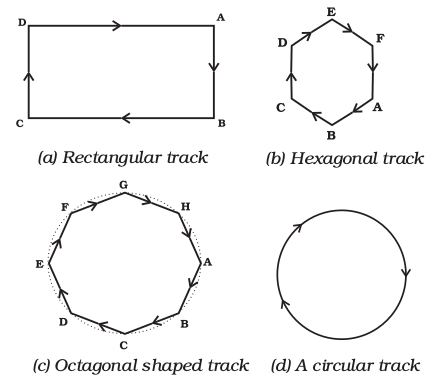Uniform Circular Motion | Science Class 9 PDF Download
| Table of contents |

|
| Circular Motion |

|
| Difference between Uniform Linear Motion and Uniform Circular Motion |

|
| Radian |

|
| Angular Displacement and Angular Velocity |

|
Circular Motion
Motion of a particle (small body)along a circle (circular path), is called circular motion.
If the body covers equal distances along the circumference of the circle, in equal intervals of time, then motion is said to be a uniform circular motion. When a body moves along a circular path, then its direction of motion changes continuously.
Note: A uniform circular motion is a motion in which speed remain constant but direction of velocity changes continuously.

Examples of Uniform Circular Motion
(ii) Motion of a satellite around its planet.
(iii) Motion of earth around the sun.
(iv) An athlete running on a circular track with constant speed.
(v) Motion of tips of the second hand, minute hand and hour hand of a wrist watch.
- Circular motion is an accelerated motion.
- In a circular motion, velocity changes in direction only, the motion is said to be accelerated.
- Uniform linear motion is not accelerated but uniform circular motion is accelerated.
Difference between Uniform Linear Motion and Uniform Circular Motion
Uniform linear motion | Uniform circular motion |
The direction of motion does not change. | The direction of motion changes |
The motion is non-accelerated | The motion is accelerated |
Radian
It is a convenient unit for measuring angles in physics.
The arc AB of the circle, has length l and subtends an angle q at the centre C.
If ∠ACB = θ radians
One radian is defined as the angle subtended at the centre of the circle by an arc which is equal in length to its radius.
Angle subtended by the circumference at the centre.
2π radians = 360°
1 radian = 57.30
Angular Displacement and Angular Velocity
The angle covered by a body in 1 sec. is called angular velocity.
It is usually denoted by w and measured in radian per sec.
If q is the angle covered in time 't' then :
Angular velocity = Angular displacement \ time taken
Unit Angular displacement = θ (in radian)
Angular velocity ω
Relation between Linear Velocity and Angular Velocity.
Higher Order Thinking Skill
Projectile's Motion
A projectile is an object moving in space (or air) under the effect of gravitational effect of earth alone (without any other external force) is called the projectile motion and the object is caled the projectile.
The examples of projectile are missile shot from a gun, a bomb released from an airplane, a batted cricket ball, a ball thrown at some angle with horizontal and a rocket after its fuel is exhausted.
The motion of a projectile may always be resolved into two perpendicular straight line motions, viz, horizontal and vertical motions. These motions in perpendicular directions are quite independent of each other.
Path of Projectile
Consider a body is projected with velocity, making an angle θ, point of projection O as the origin the axis OX and OY being horizontal and vertical directions respectively. The initial velocity may be resolved into horizontal and vertical components.
Horizontal Component ux = u cosθ
Vertical Component uy = u sinθ
The trajectory of the projectile is parabolic.
Time of Flight, T
The time in which the porjectile again meets the horizontal plane is called the time of flight. The net vertical displacement of projectile in time of flight is zero (i.e. y = 0) ; therefore, time of flight (T) of projectile from
Maximum Height, H
At maximum height vertical component of projectile's velocity is zero, i.e., vy = 0
from relation v2 = u2 + 2as, we have
This equation shows that the height H is maximum when That is why the athlete in high jump tries to throw his body vertically upward.
Range of Projectile
The horizontal distance traversed by the projectile in time of flight T is called the range of projectile.
∴ Range R = horizontal speed × time of flight = ux T
For maximum range sin 2θ = 1 or 2θ = 90° or θ = 45°
and the maximum range,
Obviously the maximum range is achieved when angle of projection is 45°.
|
84 videos|478 docs|60 tests
|
FAQs on Uniform Circular Motion - Science Class 9
| 1. What is circular motion? |  |
| 2. What is the difference between uniform linear motion and uniform circular motion? |  |
| 3. What is a radian? |  |
| 4. What is angular displacement and angular velocity? |  |
| 5. What are some real-life examples of uniform circular motion? |  |
















